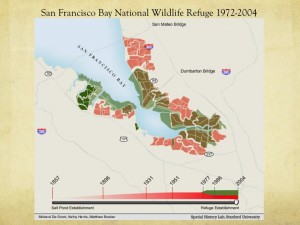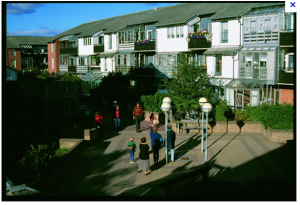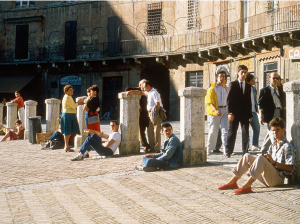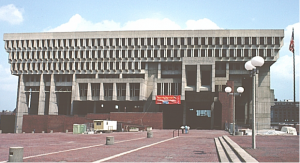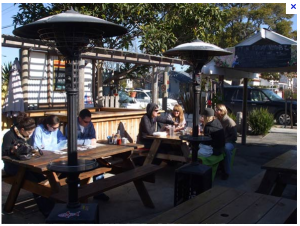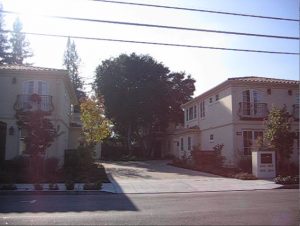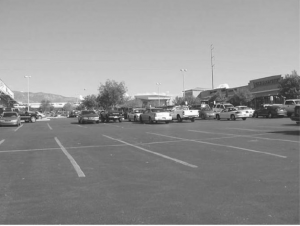The ubiquitous teddy bear has its origins in an politically framed anecdote about Teddy Roosevelt, and a broad shift in American attitudes toward wildlife. As predators headed toward extinction and the country urbanized, bears shifted from malevolent opponents to cuddly plush toys.

John Mooalem started wondering why his baby daughter’s clothes and things had so many cute animal images. The question led the journalist to investigate efforts to protect three endangered species from extinction, and to unearth the history, evolution, and unsettled present of wildlife protection. The teddy bear story, and many other strange and revealing tales are recounted in Wild Ones: A Sometimes Dismaying, Weirdly Reassuring Story About Looking at People Looking at Animals in America.
Mooallem’s discoveries raise serious doubts for the prospect that conservation can restore wild nature. At Churchill, Manitoba, the ecotourist destination hosting the much-photographed colony of polar bears that are the poster creatures of climate change, the warming climate will soon make the place uninhabitable for the bears. Human stewards will need to decide whether to leave the creatures wild and watch them die, or rescue the animals at the cost of the reputation of untouched wildness.
In Antioch, California, scientists and volunteers make heroic efforts to keep an endangered butterfly species alive, in a landscape almost completely denuded of the sand dune habitat that hosted the butterflies and other rare species. It turns out, though, that genetically nearly indistinguishable insects are relatively plentiful, and can be bred to generate the endangered subspecies distinctive visual appearance.

From Wisconson to Florida, a quarrelsome but persistent bunch of ultralight hobby aircraft pilots train tiny colonies of whooping cranes to migrate along new routes. The birds are learning to migrate on their own, although they have not yet successfully established new breeding populations.

In his research, Mooallem finds multiple elders in several generations of various conservation movements who started as young idealists and have at some point given up the fight, only to be replaced by youthful crusaders who start with a lower baseline expectation of habitat and population.
Following the paths where his research leads him, Moallem runs into contested and unresolved philosophical and scientific disputes about how to perceive, and how to deal with environmental degradation. But he doesn’t ask the questions in a straight-up way, and doesn’t follow some of the questions as far as they lead.
Is the Endangered Species Act an ultimately doomed effort to maintain animals in perpetuity on costly life support, while half of known species slide rapidly toward extinction? Or is it a dramatically successful program in which 90 percent of listed species are recovering on schedule? What conclusion should be drawn from a research finding that 80 percent of species on the endangered list are “conservation reliant”, in need of some sort of persistent intervention, such as control of predators or prevention of human disturbance.
In the chapter on polar bears, Mooallem is skeptical of the sentimental pleas to American consumers to sympathize with the imperiled polar bears, even as they keep driving SUVs. He observes the irony that wild animals became cute and cuddly objects for children after they ceased being day to day threats for urban neighborhoods far from the nearest predators. But he doesn’t go very far in questioning the perspective foundational to the modern environmental movement that the natural world is and ought to be pristine and free of human intervention.
This is the case, even though Mooallem recounts a story in the Antioch chapter about efforts to preserve an old-growth oak and hickory forest in New Jersey, which ran into challenges fighting invasive maple trees. Scientists analyzed the growth rings of ancient trees and discovered that the traditional oak and hickory landscape was actually fostered by Native Americans who regularly burned the underbrush. Mooallem cites the New Jersey history via legal scholar Holly Doremus, who critiques the idea that “what nature needs most is for people to leave it alone”.. that a landscape will “automatically produce the preferred human outcome, a perfect Garden of Eden, if it is simply walled off from human influence.”
The lesson Mooallem draws is that nature’s responses to human choices are unpredictable, and may not have the desired results. “Nature perpetually absorbs what we do or don’t do it it, and disinterestedly spits out the effect of these causes. Nature is not a photograph that will always look good if we keep our fingerprints off it. It’s a calculator, adding up numbers we don’t always realize we’re pressing and confronting us with the sum. But Mooallem’s pessimistic conclusion may not be what Doremus meant ( her Berkeley intro course on Environmental Law is online and she blogs so this is fairly easily answerable).
Native American practices of “gardening” the seemingly pristine New England wilderness were researched and documented by scholar William Cronon in a landmark book of environmental history, “Changes in the Land,” first published in 1983. Cronon’s conclusion, and a theme of his work, is that the ideal of “nature” as separate from humans is a modern and invented concept. Other works of environmental history, including these books on wetland restoration, document more Native American traditions of modifying landscapes that appeared “untouched by human hands” to European newcomers.
In recent years, the Nature Conservancy and other environmental NGOs have shifted away from a vision of restoring nature to a pristine, pre-human state, toward a vision of protecting nature in a way that is sustainable for animals, plants and people. Following this philosophy, ongoing investments to maintain species aren’t necessarily cause for angst, chagrin, and assessment of failure. The question becomes what investments to make, what investments to prioritize, and why?
This is now the subject of scientific debate. Should the justification for conservation be biodiversity, preserving the greatest genetic richness? Should the justification be providing ecosystem services, such as cleaning water and reducing the impact of floods. Should the justification be protecting the ecosystem, and identifying the key species, and the geographic parameters, that will help maintain the ecosystem?
The chapter on the Antioch metalmark butterfly depicts the futility of the attempt to maintain the endangered butterfly and its host buckwheat plant. Now that the sand dunes that fostered the ecosystem are all gone, the new landscape favors a wholly different constellation of plants and animals. Removing migrant species that are better adapted to the new landscape is an unending, sysiphean battle. The chapter also reports evidence that there are other metalmark butterflies that are nearly genetically identical, though they have different wing coloring and patterns. The author finds the shifting definitions of species vertigo-inducing, and simultaneously admires and doubts the value of quixotic efforts to preserve nature in Antioch’s grim-looking industrial landscape.
One could look at the same evidence in the chapter and reach very different conclusions. Seeking to protect the butterfly species after the habitat is gone beyond repair or restoration is not worth it. But efforts to protect species by restoring viable habitat – as in this project led by Liam O’Brien, one of the the author’s sources and heroes in the same chapter – are promising investments. Diagnosing species by surface appearance without genetic evidence is scientifically obsolete. And it would probably be better to focus on protecting the nearby viable habitat for the butterfly populations that are nearly genetically identical.
Mooallem has an existential crises when he learns that even the apparently untouched North American wilderness encountered by Europeans once had huge land animals – giant mammoths, camels, sloths and others – which may have been wiped out by early human hunters. He doesn’t trace the environmental history further back through waves of population and extinction over millions of years. On the one hand the deep history isn’t comforting for the human species. We could become casualties of the current extinction wave. Current civilizations could go under. On the other hand, deep history shows that there is not and has never been a pristine historical baseline.
The responsibility to monitor, restore, and help maintain the earth’s habitats is extremely daunting – humanity may not succeed at it. But we have already demonstrated the ability to destroy at a huge scale. We may not have a choice. Global warming and ocean acidification may be nature’s way of telling humanity, you break it, you bought it.
The framing of environmental protection as gardening is often used as a pretext for clear-cutting, bottom trawling, and other practices that over-aggressively harvest resources with the excuse that humans will benefit and the environment will recover. The stewardship metaphor can easily be used to imply an unwarranted overconfidence that humans are destined to master the rest of the earth’s species, and the belief that a supernatural being has assured humanity that our rule is just and beneficent (just ask the buffalo and the passenger pigeons). But the romantic idea of pristine nature is a different myth that is getting in the way of making needed choices.
I first came across the Teddy Bear story in an episode of the 99% Invisible podcast, which tells fascinating stories of the hidden and quirky origins of artifacts of modern life, such as revolving doors and the color of currency. The teddy bear story from Wild Ones uncharacteristically deals with the natural world; otherwise the ironic, geeky, bemused yet sincere attitude fits right in. This chronically ironic perspective, along with the journalistic method of attempting to weave a larger story from the threads of many anecdotes on a theme, together prevents the book from thoroughly grappling with the scientific and philosophical issues it raises.
But it tells fascinating and compelling stories, raises important issues, and provides more than enough references for readers to follow up and take further, so I strongly recommend the book.
